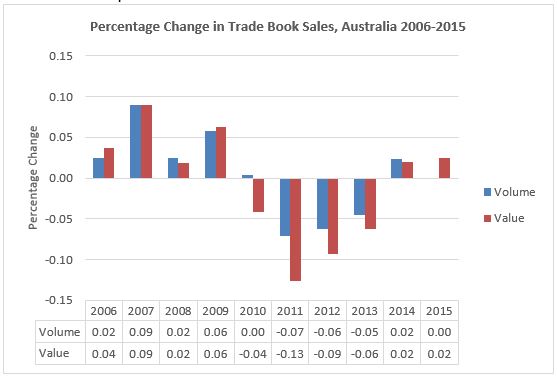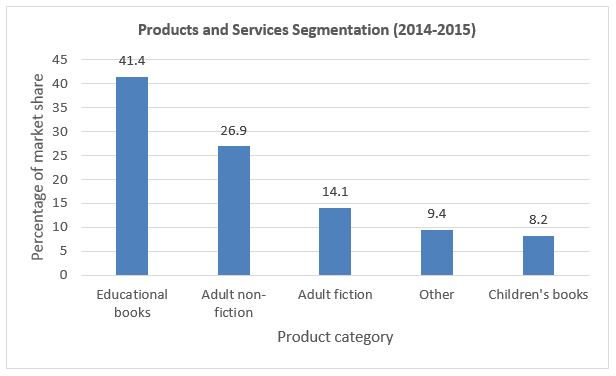Disruption and Innovation in the Australian Book Industry
An Australian-first study by Macquarie University of the country’s book publishing industry reveals considerable innovation in response to the digital disruption that has resulted in a significant drop in onshore book sales.
The initial research phase of the study involved participation from SPN members Pantera Press, Spinifex Press, Pitt Street Poetry, Overland, Re.Press, Kids’ Own Publishing and Magabala Books.
The study uncovers the strategies being used by Australian publishers by analysing findings from interviews with 25 senior Australian publishers of various sizes, across trade, education, scholarly and literary sectors.
Dr Jan Zwar, researcher at Macquarie University’s Faculty of Business and Economics, said, “As a mid-size industry, Australian publishers have been forced to work harder in order to compete globally and deal with major changes that have been occurring across the industry.”
“We saw publishers develop defensive strategies to entrants such as Google, Apple and Amazon, for example the development of direct to consumer print and ebook sales. In some cases, such as Harlequin, the sale of ebooks is an extension of its postal mail order services to readers.”
“While other publishers employed opportunistic strategies that leveraged digital technology, such as open access publishing and the use of metadata, apps and social media for promotion.”
“For instance, Momentum was set up in Australia by Pan Macmillian to experiment with epublishing, ebook pricing and digital sales channels. Kylie Scott, who is now a New York Times best-selling author, was discovered through Momentum’s open submission process.”
“Other strategies aimed to open up new, different markets and to create new business models, for instance new types of royalty agreements between publishers and authors and moves to subscription models,” added Dr Zwar.
The report also looks at the structural changes within the industry and the impact this is having on book sales.
For instance, Big W is now believed to be the single biggest book retailer in Australia. The online retailer Booktopia, purchased Bookworld in 2015 and is now the dominant Australian-based online retailer, with an estimated market share of six to seven per cent.
The research was the second part of a larger project that looked at Australia’s book industry, which included a report on Australian authors that was released in October 2015.
More information on both reports can be found on the Macquarie University website.
Overview of the Australian book publishing industry
- After several years of decline, 2015 was the first year in which onshore trade book sales increased. Trade sales in 2015 were worth approximately $979 million, which is 2.4 per cent higher in value compared to the previous year to date period and education sales were approximately $410 million.
- The chart below shows the turbulence of recent years. Major factors include the upswings created by blockbusters including Harry Potter, Twilight, Fifty Shades of Grey and most recently, adult colouring books. Downswings include the absence of blockbusters compared to the previous year, the take-up of offshore sales to Amazon, Amazon’s Book Depository and other overseas retailers, and the closure of REDGroup Retail in 2011 which was associated with a 20 per cent contraction in trade book sales.

- Offshore sales are estimated at 250 million dollars per year but there are no reliable figures. It is likely to vary according to fluctuations in the exchange rate. Australian publishers are developing strategies to gain prominence for their books in online retail stores such as temporary price reductions to drive titles up bestseller lists.
- The average selling price of books in Australia has gone down from a peak of $19.90 in 2009 to $17.35 in 2015 as publishers have responded to price competition from overseas retailers.
- Fiction titles which have the exceptional backing of large publishers may achieve sales of 50,000 – 100,000 copies or more while specialist, academic titles and books of poetry may sell in the low hundreds.
- Currently, approximately 33-36 per cent of trade books sold in Australia are written by Australian authors, according to industry estimates.
- Turnover in bricks and mortar retail outlets in Australia was estimated at over $900 million in 2013-2014.
| Channel | Value of turnover | Comments |
| Bookchains | 38% | Includes Dymocks, QBD, Booktopia and Koorong plus other bookseller chains. |
| Discount and Department Stores (DDS) | 28% | Eg., Big W, Kmart and Target; Myer and David Jones. |
| Independent bookstores | 27% | Independent bookstores are particularly important for launching debut Australian titles. |
| Other | 7% |
- At 41.4 per cent, educational books have the largest market share.

- Print books remain popular. For example, Michelle LaForest reports that approximately 75 per cent of Harlequin Australia’s sales are print books. Louise Sherwin-Stark at Hachette estimates that digital sales comprise 17-20 per cent of most large publishers’ turnover.
- The move to online retailing is one of the biggest areas of innovation in the book industry over the past decade. Ibisworld predicts that 19.7 per cent of trade sales in 2015/16 will be through online retailers.
- However, bricks and mortar booksellers remain key to the sales success of many debut titles by Australian authors. The strategies behind the success of The Lost Swimmer, by Ann Turner (published by Simon & Schuster), Lost and Found by Brooke Davis (published by Hachette) and The Tea Chest by Josephine Moon (published by Allen & Unwin) included planning campaigns to win the backing of bricks and mortar booksellers up to twelve months before the books were released and touring authors to meet key booksellers months prior to their launch.
- YouTube has created opportunities for the emergence of young celebrities who are now signing book deals. The Janoskians is a prankster comedy group from Melbourne that has over 2 million YouTube subscribers internationally. They have signed a book deal with Atria, a US imprint of Simon and Schuster, for the release of their first book.
